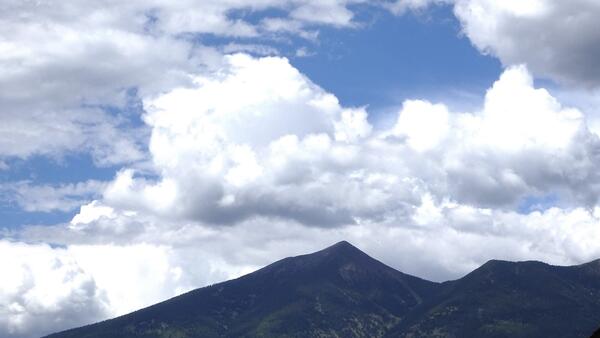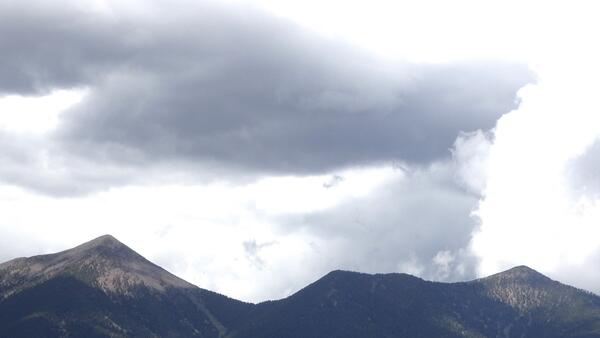The nature of monsoons
“Why are the desert blooms that spring to life after a monsoon so magnificent? The answer is – their impermanence …” — Alaric Hutchinson
Summer rains, monsoons, in the California deserts are persnickety at best. Some years they stick around for weeks and months at a time, while other years (and seeming increasingly so) they do not show up at all. When they do show up, it is typically sometime between July and early September, when the desert is at its hottest. The rains can be heavy but isolated to maybe a few square miles more or less. If you are not within the rain zone, all you get is humidity. If you are where the rain is falling, the temperatures can drop 20-40 degrees, from well above 100 to maybe 75 degrees, refreshing and exciting because with the rain there is almost always thunder and lightning, and sometimes flash floods.
Monsoons occur when it is especially hot, when that hot rising air creates enough of a vacuum to pull in the wet air from the Gulf. That means a lot of the rain hitting the baked earth evaporates before it can quench the thirst of desert plants. But monsoonal storms are sometimes much stronger, dropping more rain per minute than the often-gentler winter rains, so even with increased evaporation, there can still be enough to make a difference for desert plants. When you see the cut banks of desert washes, the force needed to move that much water, rock, gravel, and sand was almost always due to a monsoonal storm. Occasionally, a hurricane will bring especially strong winds and heavy rains. 1n 1939 and again in 1976, both in September at the tail end of the monsoon season, hurricanes hit the Coachella Valley causing widespread flooding. The 1976 flooding left the sand dunes of what is now the Coachella Valley National Wildlife Refuge looking like an archipelago of sand islands surrounded by water several feet deep.
Winter rains begin as low-pressure cells above the Bering Sea, saturated with water vapor and then shifting south and east pushed along by the whims of the jet stream. If a cell reaches the California deserts and is strong enough to still have water after the mountains try to wring as much of that precious liquid as possible, then usually the desert may get pelted with a gentle, steady rain across a broad front. Sometimes strong storms, strong enough to cause flooding, squeak through but they are rare. Cooler winter temperatures mean less evaporation and so more rainwater can be absorbed by the soil, and eventually plant roots. None of that is true for summer monsoons. By July the desert temperatures are at their peak. Hot air rises, and the void created must be filled by cooler air, usually coming from an air mass flowing over oceans.
For most of the arid west of North America, that somewhat cooler, water-saturated air comes from the Gulf of Mexico. The monsoons first reach the Chihuahuan Desert, and if strong enough will reach to the Sonoran Desert. Only when those air masses still have moisture after drenching the Chihuahuan and Sonoran Deserts, will they then reach the Colorado and Mojave Deserts. The Chihuahuan Desert gets first dibs, and so regularly receives summer rain (but little or no winter rain). The Sonoran Desert is next, getting monsoons more often than not, but still there are some years when the monsoons are weak or never show up. The Colorado and Mojave Deserts are last in line and often do without. Although, if conditions are just right, they might get a wet air mass flowing up the Gulf of California between the Mexican states of Baja California and the Sonoran mainland. Winter rains reverse this pattern. Winter storms strong enough to break through the Pacific coast mountain spine hit the Great Basin, Mojave, and then Colorado Deserts first. Then some reach the Sonoran Desert, but none or almost none make it to the Chihuahuan Desert. These differences in the expectation of summer rain versus winter rain define the boundaries of the deserts of North America.
Typically, the water-laden monsoonal air mass flows across the desert flats only rarely falling from the sky as rain, but when it hits a mountain and pushes into cooler air at higher elevations, the warm-wet air cools and so loses its ability to hold onto water vapor, and the rains come down. Desert mountains, those sky islands, get much more rain than the surrounding desert flats, and that, plus the elevation-temperature gradients fosters much higher biodiversity. Still, the monsoons are persnickety. The rains may fall on one mountain peak and not an adjacent one, or on one slope and not another, or might be strong enough to fill otherwise dry washes and flow down toward the desert flats.
Indigenous people, occupying the Sonoran and Chihuahuan deserts for thousands of years, depended on those flowing washes to water their garden plots where they grew corn, beans, squash, and cotton. Sometimes their gardens were in or adjacent to the washes, other times the people dug extensive canals training water to go where they needed it. Their harvests were critical to the peoples’ survival. Hundreds and thousands of years ago the monsoons were more dependable, less persnickety. People in the Colorado and Mojave Deserts had to deal with the less dependable nature of the monsoons, and so any garden plots were necessarily associated with permanent creeks and springs rather than persnickety monsoons.
Patterns of vegetation across our desert mountains reveal the frequency and distribution of monsoons. Certain species, such as ocotillo, are widespread in both the Chihuahuan and Sonoran Deserts; they rely on summer rains for their seedlings to survive summer temperatures and drought. Ocotillos are abundant across the hillsides in Anza Borrego Desert State Park, as well as the eastern portions of the Santa Rosa Mountains bordering the Coachella Valley. However, moving westward ocotillos quickly diminish, and are absent from the San Jacinto and San Bernardino Mountains, showing up again in the eastern Little San Bernadino Mountains and the scattered mountains toward the Colorado River. Desert agaves have a similar distribution. Monsoons move into the Coachella Valley from the south and east, hitting Anza Borrego and the eastern Santa Rosa Mountains and Little San Bernardino Mountains first, where they release much of their precious water.
There are other clues related to the persnickety nature of monsoons. Traveling on highways across our deserts in fall or winter a naturalist will see the most common and abundant desert shrub, creosote bush, dominating the landscape. At that time of year, the creosotes are a dull olive brown, having mostly shuttered their photosynthetic factories, waiting until the rains come again. However, once in a while there will be a patch of creosote bushes that are bright green, with their photosynthetic factories working at full tilt. That bright green color defines the footprint of a monsoonal downpour that may have occurred months before. Those “green patches,” especially if augmented by winter rain, can portend the best spring wildflower displays and so be places to visit in search of desert beauty. It’s as if the summer rain somehow predisposes the seedbank of desert annuals to “get ready” and with added winter rain the landscape bursts into a riot of wildflowers.
Despite the high evaporation rates during desert summers, monsoons can become part of the answer for explaining long-term patterns of biodiversity as well as annual variations in the ephemeral nature of desert wildflower displays. Without monsoons, ocotillo seedling establishment and survival is reduced, if not eliminated. Without monsoons desert tortoises won’t get that summer drink that allows them to void their increasingly toxic urinary bladders and refill them with fresh water. If the following winter and spring are dry as well, many tortoises won’t survive. As the effects of modern climate change become increasingly entrenched, predicting what will happen with monsoons, or any forecasts of rainfall patterns, is challenging. One might surmise that as it gets warmer, there will be higher rates of evaporation, and with more moisture being carried in the warm air the monsoons might get stronger. So far that has not been the case. If it were to happen, the Colorado and Mojave Deserts would start looking more like the Sonoran Desert. Saguaro cacti, and the overall cactus diversity of the Sonoran Desert could shift into California. So far there is nothing to suggest that is happening or will happen, but it is an interesting notion.

